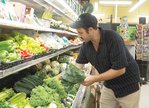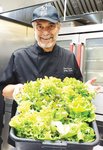


Editor’s note: Chatham County’s farmers and restaurants have a unique partnership, one that’s designed to appeal to the palates of locals with discriminating — and healthy — tastes. In the first of a two-part series, the News + Record looks at what transpires along the winding road from farm to fork. This week: produce. Next week: meat.
It was a hot and oppressively humid Thursday afternoon and one of Pittsboro’s two weekly farmer’s markets was slowly taking shape just east of downtown. Ben Shields of In Good Heart Farm, unloaded pints of multicolored cherry tomatoes, while Meredith Leight of Granite Springs Farm displayed a few varieties of heirloom okra — some of which bore a deep purple tint. There were peaches and essential oils, peppers and goat cheese, onions and garlic bulbs for sale, and there was a crackle in the atmosphere; an edge to the heat, to the breeze, to the very feel of the air, presaging an evening of storms.
Beads of sweat stand out on Shields’ face as he sets up his stall. For him, the farming life is very direct. There’s no middleman, no markup — even when he sells to restaurants such as Angelina’s Cafe or Postal Fish Company in Pittsboro, he sells directly. From his farm in Hickory Mountain Township, it’s a quick drive to these restaurants or to the Chatham Marketplace.
“It’s about as short as you can get,” he says.
Next stall over, Leight tells a similar story. For small farmers, relationships are key. So she sells directly to restaurants, and for her, developing relationships with chefs is no different from getting to know customers at farmer’s markets. She brings up an ethical component — namely that if you don’t know where your food originally comes from, as is the case at larger grocery stores, you don’t know if human rights abuses happened along the line. But there are also matter-of-fact reasons.
“We’re not big enough to go through distributors,” Leight says.
This is the story for many small farmers — build relationships and sell directly — but not all. Indeed, there are steps in the process between farm and fork that are essential when farms scale up, either in size or in geographical reach. Exploring the often invisible supply chain that local food travels when it isn’t or can’t be sold directly is a fascinating journey.
With produce, the supply chain can include services that would put a burden on farmers’ time and resources — processing such as dicing, milling or juicing. And sometimes it’s simply a question of the number of miles between farm and fork.
“Delivering to a restaurant, if it’s down the street, is a little different,” says Krista Morgan. “There is a little more distance and the distributor may require your produce to be refrigerated the entire time. Regulations are a little different. The needs are different.”
As market access coordinator with Carolina Farm Stewardship Association, a Pittsboro-based nonprofit that serves sustainability-minded farmers in both Carolinas, Morgan’s job is to connect farmers to buyers. She guides growers in everything from packaging and labeling to figuring out what to grow and how to grow it. Infrastructure, packing sheds, food safety practices — these are all in her wheelhouse, as are the many destinations aside from grocery stores and restaurants that local produce can have.
“You’ve got distributors who go to grocery stores. You’ve also got distributors who go to foodservice or public school systems, military bases, prisons,” Morgan says. “You’ve also got private universities who tend to buy more than public because their funds are unrestricted.”
She breaks these down into three categories: small-, medium- and large-scale buyers, which opens up another consideration. Larger kitchens simply need more food.
“If I want fresh tomatoes, I go down to Marshall’s Produce Stand and get fresh local tomatoes,” says Greg Lewis. “I’m ordering 150 pounds of tomato for tomorrow. I’m ordering that from US Foods.”
It’s the lull between lunch and dinner, and Lewis, the Pittsboro Roadhouse owner, sits in his dining room, relaxed and open and speaking with casual honesty about his restaurant’s supply demands. Lewis uses some local food, but not exclusively, and sometimes it’s simply because he needs food in greater quantities than local farmers can reliably supply.
Indeed, Lewis navigates a pragmatic middle ground — buy local when he can; buy off a major restaurant supplier when price, consistency or quantity is a factor. As if to illustrate the former point, when Lewis’ cell phone rings, it’s his seafood supplier. Additionally, Lil Rooster Farms and East Branch Ginger, both in Pittsboro, are farms he relies upon for local produce.
“I have [local] lettuce. I have micro-greens, I have shoots, I have pecans — that’s what came in today, so that’s what’s on my brain,” he says.
Produce, as Lewis points out, is less regulated than meat, so is easier to sell on a local level. If one were to grow tomatoes in their yard, he volunteers, they could theoretically sell them to his restaurant.
Produce, too, has a shorter shelf life. Meat can be frozen, but produce must move quickly or perish. Chatham Marketplace buys directly from farmers such as Shields, sure, but also from Eastern Carolina Organics, a Durham-based restaurant wholesaler.
“I’d say maybe slightly less than the majority of our produce is direct from farmers currently,” says Evan Diamond, general manager at Pittsboro co-op Chatham Marketplace. Thanks to perishability, Eastern Carolina Organics boasts a streamlined process that moves farm to market rapidly, Diamond explains. “It’s an element of communication with the farmer, quickly translating that into an availability list for customers like us, getting it out there, answering questions, negotiating if things don’t show up that were supposed to — that kind of stuff. All of that happens within the course of a few days, which is pretty crazy.”
On the other hand, sometimes the steps between farmer and buyer simply don’t exist — that, or essential resources are too far away to be useful. There are only a few dicing places in North Carolina, Morgan explains, and there is also a shortage of grain mills, freezers or juicers. If one of these processing places is in the mountains, she posits, it’s of little practical use to a coastal farmer. Indeed, the lack of processors statewide is a big deal (the ones that do exist, Morgan notes, are small and can only handle so much in a day). Strategically placed processors could mean less waste, for one, as well as more business for North Carolina farmers, she explains.
“Think about it — if you can’t sell this tomato to a store because it doesn’t fit their specs, where are you doing to take it?” Morgan asks. “[Processing] opens up an avenue for all the produce that’s harvested that can’t be sold.”
Beyond that, Morgan cites the expense of a refrigerated truck as one of farmers’ biggest hurdles. They’re incredibly pricey, she explains, and many farmers find themselves stuck in a chicken-and-the-egg scenario: you need a delivery truck to fill big orders, but you need the money from big orders to buy a delivery truck.
But of course Morgan’s thought up a solution — it’s her job. “I always thought it would be cool if counties had a delivery truck that farmers could rent out,” she muses. “They don’t need it every day — they just need it for the day for the delivery.”
Is it feasible? Maybe not, but it’s a start — and a potential step in the supply chain some foods take on the sometimes direct, sometimes circuitous route from farm to fork.